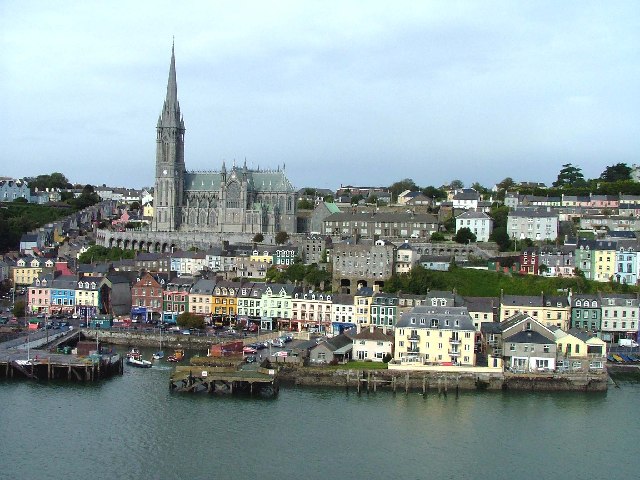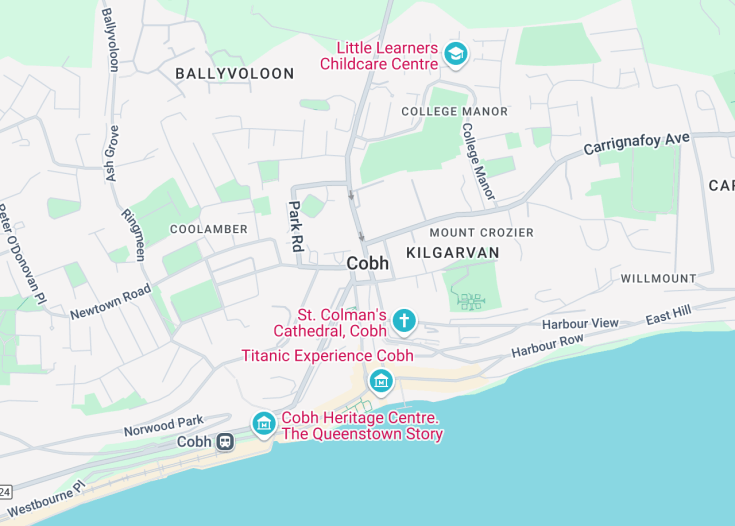Cobh, a picturesque coastal town in County Cork, Ireland, is steeped in rich maritime history and natural beauty. Renowned for its colorful facades, historic sites, and panoramic views of Cork Harbour, Cobh was the last port of call for the Titanic.
Its captivating heritage is preserved in numerous museums and attractions, including the poignant Cobh Heritage Centre which traces the steps of millions of Irish emigrants. This charming town not only offers historical insights but also delightful experiences for nature and maritime enthusiasts.
Visiting Cobh? Make sure to explore the Titanic Experience Cobh, where you can relive the ship’s fateful journey through interactive exhibits and authentic stories.
Plan a leisurely walk along the seafront promenade to enjoy the serene views and the melodious sound of the church bells from St. Colman’s Cathedral.
Top things to do & see in Cobh
Select the following sights and activities to discover best tickets and tours available in Cobh.
Cobh: A Timeless Port of History
| Country | Ireland |
| Time in Cobh | GMT+0 |
| Language spoken | English |
| Population | 12,800 (CSO 2016) |
| Currency | Euro (€, EUR) |
| Airports |
|
Located on an island in Cork Harbor, among Ireland’s largest natural harbors, the picturesque town of Cobh boasts a rich maritime and emigrant history. This charming town, known for its colorful Victorian homes that sprawl up the hillside and grandiose cathedral, acted as a major departure point for millions of Irish emigrants over the centuries, particularly during the Great Famine. Even today, Cobh’s heritage centers and museums echo the stories of those who left from its shores, including the Titanic and Lusitania disasters, linking it forever to these historical events.
The town also serves as a significant port for transatlantic cruises, adding a cosmopolitan flair to its quaint, historical charm. Visitors can walk the famed promenades where generations have trod, join ghost tours, engage in watersports, or take the memorable train journey connecting Cobh to Cork City, offering majestic harbor views. Besides its rich history, Cobh engages visitors with its vibrant culinary scene that includes fresh seafood pulled directly from Cork Harbor.
Where is Cobh?
Perched on a steep slope on an island in Cork Harbor, Southern Ireland, Cobh captures breath-taking sea vistas.
Distances:
| Route | Distance by car | Time by car |
|---|---|---|
| Cork to Cobh | 14 miles / 22.5 km | Approx. 25 mins |
| Dublin to Cobh | 160 miles / 257.5 km | Approx. 2hrs 50mins |
| Limerick to Cobh | 95 miles / 153 km | Approx. 1hr 45mins |
What is Cobh famous for?
Cobh is renowned as the Titanic’s last port of call on its ill-fated voyage in 1912. It is also an emblem of Irish emigration, offering a gateway into Ireland’s past diaspora and maritime history.
History
Prehistoric Times to Medieval Period
Cobh, originally known as Cove (“The Cove of Cork”) and later Queenstown, holds a rich tapestry of history. Archaeological evidence shows that the area has been inhabited since prehistoric times. During the medieval period, it evolved from a small fishing village into a significant maritime port. Irish monks are believed to have settled in the area around the 6th century, contributing to Cobh’s early development as a hub of fishing and commerce.
1700s – 1900s: Expansion and Emigration
By the 18th century, Cobh became an important strategic location due to its deep water port which accommodated large transatlantic ships. In the 19th century, it was notably one of the last stops of the Titanic before its ill-fated voyage in 1912. Cobh also played a crucial role during the Great Famine of 1845 to 1852, serving as a major emigration point for millions of Irish people who left for North America.
20th Century: War and Independence
In the 20th century, Cobh witnessed significant historical events. It was renamed Queenstown in 1849, in honor of a visit by Queen Victoria. During World War I, it was a pivotal base for British naval operations. The Irish War of Independence (1919-1921) saw Cobh experience dramatic military action and political turmoil. It was during this period that Cobh reclaimed its original name in 1920 as part of a wider nationalistic movement within Ireland.
Modern Day Developments
Today, Cobh is celebrated for its maritime heritage and its quaint, scenic waterfront, which houses museums, memorials, and beautifully preserved Victorian architecture. The town has also embraced tourism, offering insights into its significant role in Irish emigration history, and maritime adventures.
Visit Cobh
What to see and do in Cobh, Ireland
Exploring Cobh offers a blend of historical intrigue and scenic charm. Key attractions include the Cobh Heritage Centre, which provides a deep dive into the town’s emigration story and its connection to the Titanic.
For architectural admirers, St. Colman’s Cathedral stands as a stunning example of neo-Gothic architecture offering panoramic views of the harbour. Nature lovers can enjoy a stroll along the scenic waterfront or visit Spike Island, once a monastic site and later a military base, now transformed into a fascinating museum.
- Cobh Heritage Centre
- St. Colman’s Cathedral
- Spike Island tours
- Waterfront walks
Signature Events in Cobh
Cobh plays host to a variety of events year-round, reflecting its rich culture and history. The annual “Cobh Peoples Regatta” in August brings sailing competitions, live music, and fireworks, attracting both locals and tourists.
Around the same time, the “Cobh Animation Team” brings the town’s history to life through costume and storytelling, providing an engaging experience for all ages.
Best time to visit Cobh
The ideal time to visit Cobh is from late spring to early autumn, particularly between May and September, when the weather is pleasantly warm, and the town’s events are in full swing.
Is Cobh worth visiting?
Indeed, Cobh is well worth visiting for its remarkable blend of cultural history, stunning architecture, and compelling attractions. Its significance in global emigration as well as maritime histories—particularly pertaining to the Titanic and Lusitania—makes it a key destination for history enthusiasts. Moreover, the town’s vibrant atmosphere, enhanced by festivals and scenic beauty, ensures that there’s something for every visitor.










